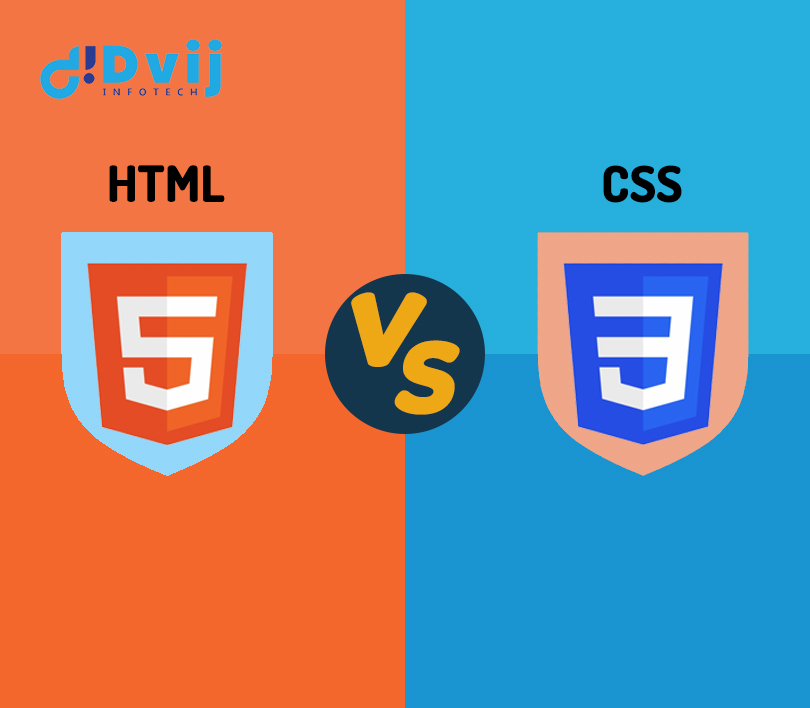What's the Difference Between HTML and CSS ? HTML and CSS are both of these languages are web scripting languages that are used to create web apps and web pages. There is, however, a significant distinction between HTML and CSS. HTML allows you to generate web pages, whereas CSS allows you to control the overall layout and design of those sites.
Only after we've written the words do we add tags or elements to HTML. After that, they all appear on the page. In this way, the browser learns about the page's headline, paragraph beginnings and endings, and much more.
In CSS, we use the rules by utilizing the CSS properties, which are divided into two categories. type, background images, background colors, font size, and other details are all specified in the presentation. The layout determines where all of the components on the screen will be placed.
What exactly is HTML?
HTML stands for HyperText Markup Language, a programming language that allows you to develop web apps and websites. The HTML is quite user-friendly, and the syntax is very loose. HTML is built into every website, and it is supported by every browser. It is available to all users for free and does not require an exclusive license. As a result, learning and coding HTML is possible.
In simple terms, HTML stands for "Text within Text." If a text contains a link, it is referred to as hypertext. When a user clicks on the hypertext, they are essentially clicking on the offered link, which redirects them to a new website (web page). To put it another way, hypertext allows two or more HTML documents/web pages to communicate with one another.
HTML is a form of computer language that serves as a primary markup language. It assists a user in applying formatting and layout principles to a text document. In a nutshell, a markup language makes a document's text more dynamic and interactive. It can easily convert available text into links, tables, and photos, among other things.
What exactly is CSS?
Cascading Style Sheets (CSS) is an acronym for Cascading Style Sheets. CSS stands for style sheet language, and it describes a document's overall appearance and formatting (drafted in a markup language). CSS allows users to give their existing HTML documents new looks. To put it another way, we can easily change the appearance of a website by making appropriate modifications to its CSS code. As a result, it adds a variety of new features to the HTML language. It basically decreases the amount of work required by regulating the layout of web pages. CSS is a fairly simple language to maintain, and it has a great community behind it.
For modifying the overall style of web pages and user interfaces, we usually use CSS in conjunction with HTML (user interfaces). It also works with XML documents of all forms, including XUL, SVG, and plain XML. We employ CSS, Javascript, and HTML to design the UI of web apps and mobile apps on most websites.
Both CSS and HTML are client-side web scripting languages that allow users to construct online pages. We'll look at the main differences between HTML and CSS in this tutorial. They differ in a variety of aspects, including simplicity of use, syntactical structure, implementation methods, properties, and more. Let's get this party started.
Parameters for HTML and CSS
-
Full-Form
The abbreviation for HTML is HyperText Markup Language. And Cascading Style Sheets (CSS) is an acronym for Cascading Style Sheets.
-
Definition
HTML is a markup language that allows a user to specify the structure of a web page. And CSS is a stylesheet language that allows a user to describe a web page's overall design and presentation, including its layout, fonts, and colors.
-
Implementation
HTML is mostly used for the content and structure of web pages. And CSS is mostly used for display and design.
-
Dependency
CSS style sheets do not work with the HTML syntax and structure. But CSS can be used with any XML-based markup language and is not dependant on the HTML language.
-
Architecture
The tags that enclose the material included in any element of a web page are used by the HTML language. And in CSS the syntax block statement can be used to express various selectors in the CSS language.
-
Support
The HTML language has a lot of community support, which allows us to use different approaches to different web page structures. And the CSS language is also well-liked in the community. It also has a large database of web design enhancements.
-
Approach
HTML can be used to create the fundamental content that appears on websites. And CSS is mostly used for online design, page style formatting, general layout design, and so on.
